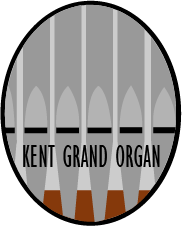Hutchings, Plaisted, & Co. Op. 78, 1878
_______________________________________________________________________________
GREAT SWELL PEDAL
16' Bourdon 16' Bourdon Bass 16' Open Diapason (W)
8' Open Diapason 16' Bourdon Treble 16' Bourdon
8' Melodia 8' Open Diapason
8' Gamba 8' Stopped Diapason
8' Dulciana 8' Salicional
4' Octave 4' Harmonic Flute (W)
4' Flute d'Amour (WM) 4' Violina
2 2/3' Twelfth 2' Flautino
2' Fifteenth 2 2/3' Cornet IIIrks.
2' Mixture IIIrks. 8' Oboe
8' Trumpet Tremolo
Manual compass: 61 notes
Pedal compass: 27 notes
Pitch: "Old Boston Pitch" as marked on one of the Pedal Bourdon pipes. Estimated
to be approx. A=449Hz Temperament: Unknown, but most likely well tempered
Wind via large double rise bellows beneath the organ, initially hand pumped but
believed to have been converted to a water motor many years later according to
oral church history.
While none of the existing key action or console remained after the electrification
and enlargement by W.W. Laws, it can be presumed the organ had usual unison couplers
and likely a few composition pedals as was the custom of the day and the tradition
of Hutchings at that time.
The diatonic facade contained the first 18 notes of the Gt. 8' Open Diapason and
the first 8 notes of the Gt. 16' Bourdon. The C and C# pipes of the Bourdon were
made with an extended side so as to serve to support some of the racking of the
facade. The two larger scale wood pipes of the facade are dummies as is the entire
upper section false length zinc tubes, intended to increase the vertical height.
The central section of the facade alternated between speaking and several non-
speaking pipes. The pipes of the facade were winded and planted on their own
pneumatic facade chest operated via lead tube transmission from the slider chest.
Most of the metal interior pipe work is of high lead content including resonators
of the reeds.
The Gt. 4' Flute d'Amour is of wood, no bored stoppers, and goes to open metal at C25.
The Mixture is 2' based with two breaks at 24 and 50.
The 16' Bourdon of the Swell was divided with the bass of 1-12, and treble 13-61, the
first six pipes mitered and of a slightly smaller scale than the Great. The 8' Stopped
Diapason goes to open metal from 49-61. Both the 8' Open Diapason and 8' Salicional of
the Swell had stopped pipes. 1-10 of the Diapason of stopped wooden pipes, and 1-7 of
the Salicional in capped metal pipes. The 4' Harmonic flute is also wooden and went to
harmonic pipes at C25. The Cornet (12-15-17) of narrow string like scale and gentle
voicing had at least one break at C#26.
Both Pedal stops are of wood. The wooden Open Diapason was quite substantial in scale
but with a lower cutup giving a decisive but not oppressive sound. The Pedal Bourdon is
also generously scaled and voiced as the lighter voice for the division.
While the organ was added to and modernized with EP pulldowns and stop action around 1924,
with the exception of reeds being relocated to unit or ventil EP chests and other stops
put in their place on the original slider chests, the Hutchings/Plaisted work remained
essentially untouched.

